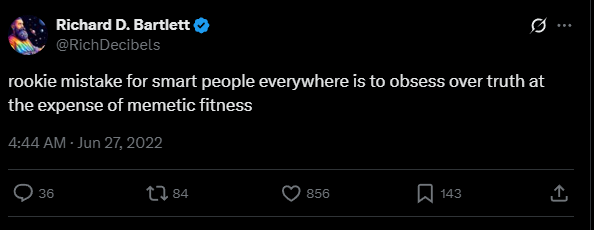Truth Isn’t Enough
The Ethics of Memetic Engineering
Richard Bartlett’s tweet captures a real tension but draws a perilous conclusion:
“Rookie mistake for smart people everywhere is to obsess over truth at the expense of memetic fitness.”
This is a sharp observation of human cognitive ecology—but a dangerous prescription if taken literally. The reason is simple: prioritizing memetic fitness over truth leads to propaganda.
1. Two Orthogonal Axes: Truth and Replicability
Truth measures correspondence with reality.
Memetic fitness measures how well an idea replicates through social systems.
They are independent dimensions. A falsehood can spread faster than a truth, and a truth can die in obscurity. Optimizing only for truth can yield sterile communication. Optimizing only for fitness yields ideological cancer.
In other words: epistemic rigor keeps the bridge standing; memetic fitness makes people want to cross it.
2. The Seductive Logic of Propaganda
When people start believing that truth and survival are incompatible, they rationalize deception as a necessary evil. This is the logic of every manipulative movement in history—religious, political, or corporate. Once you accept that lies are tools, you have no internal safeguard against becoming what you despise.
The tweet’s phrasing blurs description and advice. It reads as if the smart person’s mistake is caring too much about truth—as if deceit were the superior strategy. That framing is morally and epistemically corrosive.
3. The Constructive Kernel of Truth
There is a kernel worth keeping: truth alone doesn’t guarantee persistence. Information must be transmitted, and transmission depends on packaging—emotion, narrative, rhythm, simplicity.
Great communicators like Dawkins, Feynman, and Pinker know this: the goal is not to sacrifice truth for virality but to engineer clarity that carries truth intact.
If you ignore memetic dynamics, your truths die childless. But if you worship memetic dynamics, your culture dies stupid.
4. The Ethic of Memetic Engineering
The ethical path is not to choose between truth and spreadability but to align them.
Make truth aesthetically contagious.
Make clarity emotionally satisfying.
Make rigor narratively elegant.
This is what I call memetic engineering under epistemic constraint: designing ideas to reproduce without mutating into nonsense.
5. The Core Principle
Truth is the invariant payload; memetic fitness is the transmission protocol.
The rookie mistake isn’t obsessing over truth—it’s assuming truth alone will spread. Truth must be made luminous, not diluted. Make the signal sharp enough, and it cuts through everything else.



